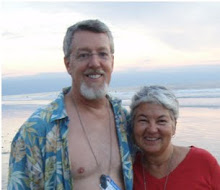
On Tuesday, April 6th, we finally left Mazatlan and headed for Ensenada de Muertos (the ominously named, but pretty, Cove of Death) on the Eastern Cape of the Baja peninsula. Crossing the Sea of Cortez is often challenging due to strong winds and waves, so we were careful to check the weather reports. They predicted light winds for Tuesday and stronger winds for Wednesday, but the maximum winds were predicted to be 15-20 knots, which we thought we could handle. It is about 175 miles from Mazatlan to Muertos, so we anticipated a two-day trip.
All went well the first day. We had moderate winds from the west, which allowed us to sail northwest up the mainland coast. The winds were predicted to shift to the north later, so I wanted to get as far north as possible to get a better sailing angle for crossing the Sea. All went as planned. Late in the day Tuesday, when we were about 45 miles up the coast from Mazatlan, the predicted windshift arrived with a bang. It happened so suddently it backwinded our jib, causing an accidental tack. We were then heading west, so we decided to take what the wind was giving us and head for Baja. By sailing on a close reach, we were able to head directly for Muertos. We sailed into a gorgeous sunset with about 15 knots of wind. The boat was charging along at about 5 knots. Things appeared to be going very well.

During the night, the wind started to build and became shifty--making it difficult to maintain our sailtrim in the dark. For convenience, we decided to drop the sails and motor until morning. By morning, the winds were much stronger, blowing at about 25 knots. We also were getting a nasty chop, with steep, short periods swells on our bow quarter. The boat was plunging and rolling heavily. To stablize it, we set the mainsail with a single reef. This helped so much we decided to kill the engine and set the jib. We sailed with a single reef most of the morning, still managing to maintain our heading toward Muertos. By afternoon, however, the winds had grown stronger yet, with gusts well over 30 knots. The boat was over-powered and heeling far over, with the toe-rails in the water. It was time for a second reef.
With two reefs in the mainsail, and the the jib mostly furled, the boat stood up and behaved much better. By adjusting the amount of jib, we were able to balance the sails perfectly so that the boat sailed close-hauled into the strong wind and swells with the helm centered. In those conditions, I really appreciated being in a heavy, "sea-kindly" boat like the Mason 33. It found a line and cut through the heavy chop with some pitching, but almost no slapping or pounding, making 3-4 knots into very strong winds and waves. I was very happy with the boat's performance in the nasty conditions.
On the other hand, some problems with the boat became apparent. As we plunged into the steep waves, the decks were often awash with seawater, and we discovered leaks in our forward hatch and in one of our deck prisms. The biggest problem was that seawater splashed over the top of our dodger, soaking the back of the cockpit where our helm is located. The dodger, with its new stitching, held up well as what seemed like bucket of water were thrown against it. Huddled under it, we were able to stay dry--mostly. The problem was that we needed to go back to the helm to check our instruments, such as the chartplotter which showed our position, as well as AIS signals for other boats, and the controls for the auto-pilot. It was impossible to visit the helm without getting drenched by flying water.
When the sun went down, and it was still blowing hard, we decided to furl the jib and motor sail with just the main up. We were standing three-hour watches, and with only one person on deck, it would have been difficult to maneuver under sail alone, should it be necessary to dodge a ship or another boat. We also worried about maintaining sail trim in the dark. With the engine running, and the mainsail double-reefed, we continued through the night.
By dawn, we could see the hills of Baja. We motored into Muertos Cove at about 8 am and dropped anchor. We were protected from the swells, but the wind was still blowing over 20 knots. Claudia and I were both exhausted from this challenging passage. We spent most of Thursday sleeping and most of today (Friday) just relaxing to recover our energy. On the whole, we came through it well, with no damage to the boat and some new knowledge about sailing upwind in heavy weather.
I have spend some time looking back at the weather predictions. The winds were clearly much stronger than predicted--at least according to the predictions when we left Tuesday morning. Interestingly, predictions that were issued Wednesday morning noted that a strong pressure gradient had developed that could produce winds over 20 knots--but that prediction was too late to help us. As I wiped the heavily encrusted salt from the boat today I was reminded to take future weather prediction with a grain of salt.

Muertos Cove is pretty. It is close enough to La Paz and Cabo to have experienced some development (and to have Telcel Broadband service). There are some condos on the beach, as well as a restaurant called the Giggling Marlin (a branch of a famous Cabo hang-out). But we won't stay long. Tomorrow morning we will be heading north toward Isla Partida, an island north of La Paz.
















